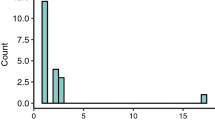Abstract
I examined historical data (1950–1984) on the duration of outbreaks of the forest tent caterpillar (Malacosoma disstria) in northern Ontario, Canada. Outbreak duration was compared to host tree species dominance and forest structure over large areas of boreal forest partially cleared for agriculture. Abundance of the principal host tree species Populus tremuloides had no consistent effect on duration of outbreak within forest districts, and was negatively correlated with duration of outbreaks among the eight forest districts examined. The amount of forest edge per km2 was the best, and most consistent, predictor of the duration of tent caterpillar outbreaks both within individual forest districts and among forest districts. Because forest tent caterpillar populations are driven largely by the impact of parasitoids and pathogens, results here suggest that large-scale increase in forest fragmentation affects the interaction between these natural enemies and forest tent caterpillar. Increased clearing and fragmentation of boreal forests, by agriculture and forestry, may be exacerbating outbreaks of this forest defoliator.
Similar content being viewed by others
References
Alstad DN, Edmonds GF (1982) Effects of air pollutants on insect populations. Ann Rev Ent 27: 369–384
Anonymous (1991a) Forest Insect and Disease Survey Conditions in Ontario, Summer, 1991 Forestry Canada Survey Bulletin
Anonymous (1991b) Ontario Ministry of Agriculture and Food Annual Statistics, publication #20
Batzer HO (1955) Some effects of defoliation of aspen, Populus tremuloides Michx., stands in northern Minnesota by the forest tent caterpillar, Malacosoma disstria Hbn., with notes on parasitism of cocoons by Sarcophaga aldrichi Park. and cocooning habits of the host. MSc Thesis, University of Minnesota, St. Paul
Bellinger RG, Ravlin FW, McManus ML (1989) Forest edge effects and thier influence on gypsy moth (Lepidoptera: Lymantriidae) egg mass distributions. Env Ent 18: 840–843
Clark EC (1958) Ecology of the polyhedrosis of tent caterpillars. Ecology 39: 132–139
Courtney SP, Courtney S (1982) The “edge-effect” in butterfly oviposition: causality in Anthocharis cardamines and related species. Ecol Ent 7: 131–137
Daniel CJ (1990) Climate and outbreaks of the forest tent caterpillar in Ontario. MSc Thesis University of British Columbia, Vancouver
Geiger R (1965) The Climate Near the Ground, Harvard University Press
Hassell MP, Comins HN, May RM (1991) Spatial structure and chaos in insect population dynamics. Nature 353: 255–258
Hastings A (1990) Spatial heterogeneity and ecological models. Ecology 71: 426–428
Heliövaara K, Väisänen R (1990) Changes in population dynamics of pine insects induced by air pollution. In: Watt AD, Leather SR, Hunter MD, Kidd NAC (eds) Population Dynamics of Forest Insects, Intercept, Andover, pp 209–218
Hodson AC (1939) Sarcophaga aldrichi Parker as a parasite of Malacosoma disstria Hbn. J Econ Ent 32: 396–401
Hodson AC (1941) An ecological study of the forest tent caterpillar, Malacosoma disstria Hbn., in Northern Minnesota, University of Minnesota Agricultural Station Technical Bulletin 148
Hodson AC (1977) Some aspects of forest tent caterpillar population dynamics. University of Minnesota Agricultural Station Technical Bulletin 310: 5–16
Huffaker CB (1958) Experimental studies on predation: dispersion factors and predator-prey oscillations. Hilgardia 27: 343–383
Hutchinson TC, Whitby LM (1976) The effects of acid rainfall and heavy metal particulates on a boreal forest ecosystem near the Sudbury smelting region of Canada. USDA Forest Service Technical Bulletin NE-23: 745–765
Kareiva P (1987) Habitat fragmentation and the stability of predator-prey interactions. Nature 326: 388–390
Linzon SN (1972) Effects of sulphur oxides on vegetation. Forestry Chronicle 48: 182–186
Moore LV, Myers JH, Eng R (1988) Western tent caterpillars prefer the sunny side of the tree, but why? Oikos 51: 321–326
Reeve J (1988) Environmental variability, migration, and persistence in host-parasitoid systems. Am Nat 132: 810–835
Sippell WL (1957) A study of the forest tent caterpillar Malacosoma disstria Hbn., and its parasite complex in Ontario. PhD Thesis Univ of Michigan, Ann Arbor
Sippell WL (1962) Outbreaks of the forest tent caterpillar, Malacosoma disstria Hbn., a periodic defoliator of broad-leaved trees in Ontario. Can Ent 94: 408–416
Stairs GR (1966) Transmission of virus in tent caterpillar populations. Can Ent 98: 1100–1104
Taylor AD (1990) Metapopulations, dispersal and predator-prey dynamics: an overview. Ecology 71: 429–433
Taylor AD (1991) Studying metapopulation effects in predator-prey systems. In: Gilpin ME, Hanski I (eds) Metapopulation Dynamics: Empirical and Theoretical Investigations, Academic Press, London, pp 305–323
Tenow O, Larsson S (1987) Consumption by needle-eating insects on Scots pine in relation to season and stand age. Holarctic Ecol 10: 249–260
Witter JA, Kulman HM (1979) The parasite complex of the forest tent caterpillar in Northern Minnesota. Env Ent 8: 723–731
Zar JH (1984) Biostatistical Analysis, Prentice-Hall, Englewood
Author information
Authors and Affiliations
Rights and permissions
About this article
Cite this article
Roland, J. Large-scale forest fragmentation increases the duration of tent caterpillar outbreak. Oecologia 93, 25–30 (1993). https://doi.org/10.1007/BF00321186
Received:
Accepted:
Issue Date:
DOI: https://doi.org/10.1007/BF00321186




